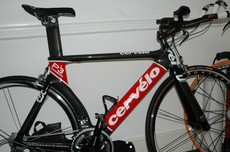 If you’re a newbie, then you are probably wondering if you should have a tri bike or not.
If you’re a newbie, then you are probably wondering if you should have a tri bike or not.
My story goes as follows…
I was a runner who got into cycling, and eventually took up the sport of triathlon. By the time I got to doing triathlons, I already had a road bike.
The big question was: Should I get a triathlon-specific bike to train and compete in triathlons?
Here are some things you might want to consider.
Tri Bike vs Road Bike
First, let’s explore the primary differences between the two.
Road bikes are especially made to handle multiple road situations such as climbing hills, navigating tight turns, and riding in packs of other cyclists where space is tight.
A triathlon bike is designed for speed, while allowing the rider to conserve as much energy as possible. This energy conservation design is helpful because biking is only one of 3 aspects of triathlon.
To accomplish this energy-efficient speed, a triathlon bike differs from a road bike in 3 primary ways:
#1 The first difference is frame geometry. The typical road bike has a 72-73 degree seat-tube angle, while a tri bike has a 76-78 degree angle. The road bike angle allows the cyclist to use his or her quadriceps more than their hamstrings, which produces the power for climbing hills and sprinting across the finish line.
So, when the ride is over on a road bike, your quads are spent. No biggie; well, unless you have to hop off your bike and run! The triathlon bike angle makes more efficient use of your hamstrings, which means your quads conserve more energy for the run afterwards.
#2 Because the tri bike forfeits a little power with the seat-tube angle, it makes 2 adjustments to compensate:
- First, a triathlon bike has aero bars. The use of aero bars puts the cyclist in a more aerodynamic position, which dramatically reduces wind resistance. The aero bars also allow the triathlete to ride in a more restful position, once again helping to conserve energy.
- The second adjustment involves your shifters. On a tri bike, the shift levers are on the tips of the aero bars (bar-end shifters), which allow the rider to shift gears while maintaining the aero position. You can add clip-on aero bars to a road bike, but they won’t have the bar-end shifters like the built-on aero bars of a tri bike.
#3 Many triathlon bikes have 650c (65 centimeter diameter) wheels instead of 700c, which is the typical road bike wheel size.
The smaller wheels weigh less and are more wind-resistant by virtue of putting the cyclist closer to the road. Tri bike wheels have a more aerodynamic ring, flat spokes, and fewer spokes than the traditional road bike wheel.
Get A Tri Bike… Eventually
 In a nutshell, a triathlon bike has incorporated changes to a typical road bike that make it lighter and more aerodynamic. You can make some of these changes to your road bike by adding aero bars and aero wheels. This may be step one as you get started in the sport of triathlon.
In a nutshell, a triathlon bike has incorporated changes to a typical road bike that make it lighter and more aerodynamic. You can make some of these changes to your road bike by adding aero bars and aero wheels. This may be step one as you get started in the sport of triathlon.
After you move past the exploration phase and decide to continue doing triathlons, I would encourage you to purchase a triathlon-specific bike. The cost of triathlon bikes range from $750 – $6,000.
Be prepared to invest some training time becoming comfortable riding in the aero bar position. Aero wheels can also be a little more difficult to ride in a cross wind.
Here’s the inside scoop on tri bike fit.



